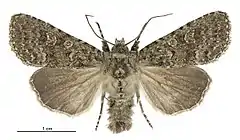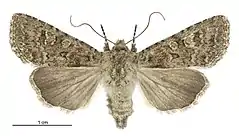Graphania omicron
Graphania omicron is a species of moth in the family Noctuidae. It is endemic to New Zealand. This species is classified as "At Risk, Naturally Uncommon" by the Department of Conservation.
| Graphania omicron | |
|---|---|
 | |
| Male | |
 | |
| Female | |
| Scientific classification | |
| Kingdom: | |
| Phylum: | |
| Class: | |
| Order: | |
| Family: | |
| Genus: | |
| Species: | G. omicron |
| Binomial name | |
| Graphania omicron | |
| Synonyms | |
| |
Taxonomy
This species was described and illustrated by George Hudson in 1898 and named Melanchra omicron.[2] It was discovered by Albert Norris in Karori, Wellington.[2] In 1928 Hudson, thinking M. omicron was the same species as Aletia inconstans, discussed the it under the latter name in his book The Butterflies and Moths of New Zealand.[3] In 1939 Hudson reinstated M. omicron as a separate species.[4] The type specimen is missing and has not been found at Museum of New Zealand Te Papa Tongarewa.[3][5] In 2019 Robert J. B. Hoare published a paper in which he undertook a major review of New Zealand noctuids. Hoare, having inspected the type material of this species, placed it within the genus Ichneutica.[6]
Description
Hudson described the species as follows:
The expansion of the wings is about 1 1⁄2 inches. The fore-wings are pale olive-green, mottled and striped with dull grey ; there is a double transverse line near the base, another at about one-fourth, and another at about one-half, passing between the orbicular and the reniform ; beyond this there are two indistinct shaded lines, and a terminal series of black marks ; the orbicular is large, almost circular, and sharply outlined in black ; the claviform is small and indistinct, and the reniform ill-defined, obscurely outlined in black towards the base. The hind-wings are brownish-grey, darker towards the termen.[2]
Distribution
This species is endemic to New Zealand.[1][7] Although regarded as being known only from Wellington,[5] Auckland Museum has specimens collected in Otago.[8] G. omicron has been recorded as occurring at Baring Head,[9] Titahi Bay,[10] Central Otago[11] and Otago Lakes.[12]
Host species and habitat
G. omicron has been recorded at raised shingle beach habitat.[9]
Conservation Status
This species has been classified as having the "At Risk, Naturally Uncommon" conservation status under the New Zealand Threat Classification System.[14]
References
| Wikimedia Commons has media related to Graphania omicron. |
| Wikispecies has information related to Graphania omicron. |
- "Graphania omicron (Hudson, 1898)". www.nzor.org.nz. Landcare Research New Zealand Ltd. Retrieved 2017-07-09.
- Hudson, George Vernon (1898). New Zealand moths and butterflies (Macro-lepidoptera). London: West, Newman & co. p. 22. doi:10.5962/bhl.title.7912.
- Dugdale, J. S. (1988). "Lepidoptera - annotated catalogue, and keys to family-group taxa" (PDF). Fauna of New Zealand. 14: 77. Retrieved 22 May 2018.
- Hudson, G. V. (1939). A supplement to the butterflies and moths of New Zealand. Wellington: Ferguson & Osborn Ltd. p. 400.
- Patrick, Brian; Dugdale, John S. (2000). Conservation status of the New Zealand lepidoptera (PDF). Wellington, N.Z.: Department of Conservation, New Zealand. p. 24. ISBN 0478218672. OCLC 154670803.
- Hoare, Robert J. B. (2019-12-09). "Noctuinae (Insecta: Lepidoptera: Noctuidae) part 2: Nivetica, Ichneutica". Fauna of New Zealand. 80: 1–455. doi:10.7931/J2/FNZ.80.
- Gordon, Dennis P., ed. (2010). New Zealand inventory of biodiversity. Volume two. Kingdom animalia : chaetognatha, ecdysozoa, ichnofossils. Vol. 2. Christchurch, N.Z.: Canterbury University Press. p. 460. ISBN 9781877257933. OCLC 973607714.
- "Graphania omicron". www.aucklandmuseum.com. Retrieved 22 May 2018.
- Crisp, Philippa (2011). "Baring Head ecological values" (PDF). www.gw.govt.nz. Retrieved 22 May 2018.
- "Graphania omicron". www.aucklandmuseum.com. Retrieved 22 May 2018.
- "Graphania omicron". www.aucklandmuseum.com. 22 November 2002. Retrieved 22 May 2018.
- "Graphania omicron". www.aucklandmuseum.com. 22 November 2002. Retrieved 22 May 2018.
- White, E. G. (1991). "The changing abundance of moths in a tussock grassland, 1962-1989, and 50-to 70-year trends" (PDF). New Zealand Journal of Ecology: 5–22.
- Hoare, R.J.B.; Dugdale, J.S.; Edwards, E.D.; Gibbs, G.W.; Patrick, B.H.; Hitchmough, R.A.; Rolfe, J.R. (2017). "Conservation status of New Zealand butterflies and moths (Lepidoptera), 2015" (PDF). New Zealand Threat Classification Series. 20: 8.